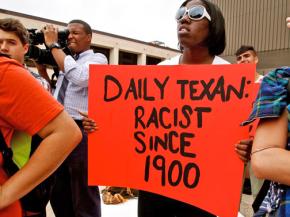No tolerance for racism
reports on how activists stood up to a vile display of racism at UT.
AS PUBLIC outrage grows against racist violence, many people are learning that incidents like the murder of Trayvon Martin aren't isolated occurrences. Trayvon's killing is the result of institutionalized racism that is alive and well in our society, and often goes unchallenged.
But no longer at the University of Texas (UT).
On March 27, the Daily Texan, UT's campus newspaper, published a disgusting racist cartoon. The drawing showed a white mother reading to her child from a book titled "Treyvon [sic] Martin and the Case of Yellow Journalism." The mother is shown reading the following: "And then the big, bad white man killed the handsome, sweet, innocent, colored boy [sic]."
The cartoon went viral on the Internet, and soon the whole country knew what students of color live with at a racist institution like the University of Texas.
That same day, there was a silent rally for Trayvon at the state Capitol building, and an extra current of anger at the racist cartoon ran through the crowd of 500 people.

Like recent marches organized by Occupy Austin, the protesters at the Capitol took over Congress Avenue for a march to City Hall. There, former UT student Chas Moore spoke to the crowd and urged people to link up the struggle against police brutality in Austin with other issues, like LGBTQ and women's rights.
After Chas' passionate speech, Michelle Uche, a UT student and member of the International Socialist Organization on campus, led the crowd in a mic check, saying, "If there are any UT students who want to organize against this cartoon and other racist issues on campus, come over here." Nearly 100 students stepped forward, and Michelle and others went to work handing out clipboards to collect contact info and facilitate a discussion about what to do.
Michelle and fellow students called for a picket of the Daily Texan office the next day, and nearly 100 students and faculty gathered there to demand that the paper's editorial board publicly apologize for publishing the cartoon, refuse to publish any future drawings from the cartoonist, and open up the editorial pages of the paper to African American Studies professors and students.
Four of the five editors came out to face the crowd, with the others standing behind Audrey White, the Daily Texan managing editor. As Audrey apologized profusely, the other editors remained silent, until the crowd pressed them to answer their questions: "What are you going to do to ensure this won't happen again? Do you think you should resign?"
The statements of the editors at the rally and the comments on the Daily Texan website revealed that the editorial board as well as a large portion of students at UT aren't aware of the oppression faced by African Americans, Latinos, Arabs and Muslims and other people of color.
A few hours later, the Daily Texan editorial board released an apology, fired the cartoonist and agreed to print any editorials submitted by African American students and faculty from the African American Studies department.
But in the days since, right-wingers on campus has tried to rally around re-instating the cartoonist. They claim they are defending free speech and have gone so far as to create an online petition that states students are offended because of a "perceived racism within the cartoon itself."
But what does it take to "perceive" the racism in this cartoon. The cartoonist is perpetuating the claim that anti-Black racism isn't real, but a myth or a bedtime story. That's something African Americans and other people of color--who are victims of police brutality, an unfair justice system and many other inequalities--know is a lie.
AUSTIN, TEXAS, is no stranger to police brutality. On March 9, a Travis County grand jury decided not to file charges against Austin police officer Nathan Wagner for shooting and killing Byron Carter, a 20-year-old African American.
Byron and his 16-year-old friend were starting their car, when two police officers approached them from behind, without identifying themselves and with guns drawn. Byron and his friend attempted to drive away as the police opened fire--which they claim was an act of self-defense.
As community activist Debbie Russell said after the ruling, "What we have been seeing across this country for years and years and years holds true in our liberal county--that it's okay to kill young men of color, and police can still get away with it."
Meanwhile, at the UT campus, north of downtown, every day, students can find statues adorning the South Mall, with Confederate generals on one side and Confederate statesmen, such as the slave owner Jefferson Davis, on the other.
This represents the neo-Confederate ideology that the university was built around. As Edmund T. Gordon, chair of the African and African Diaspora Studies department, said during an Occupy UT-sponsored walking tour of campus on the history of racism: "Privileged and elite white folks felt like vindicating the Confederacy and what the Confederacy stood for."
So it shouldn't come as any surprise that conservatives on campus think they can openly defend a racist cartoon.
For those who say we should not "overreact" to something like this cartoon, or who claim we should be patient while "all the facts come out" about Trayvon's murder, we have to ask the question: How many more Trayvons will be slain before we challenge the institutionalized racism that infects our society?
Change in society isn't going to come from above. It's going to come from the bottom up--from the students who fought to restore Trayvon's name at UT and from the voices of people around the country who are rising up to ensure that we never have another Emmett Till, Byron Carter or Trayvon Martin die at the hands of racists.


